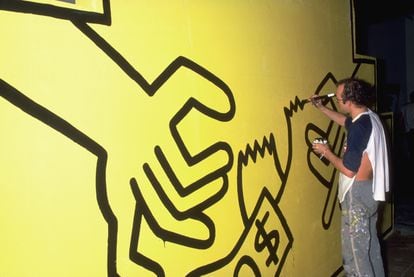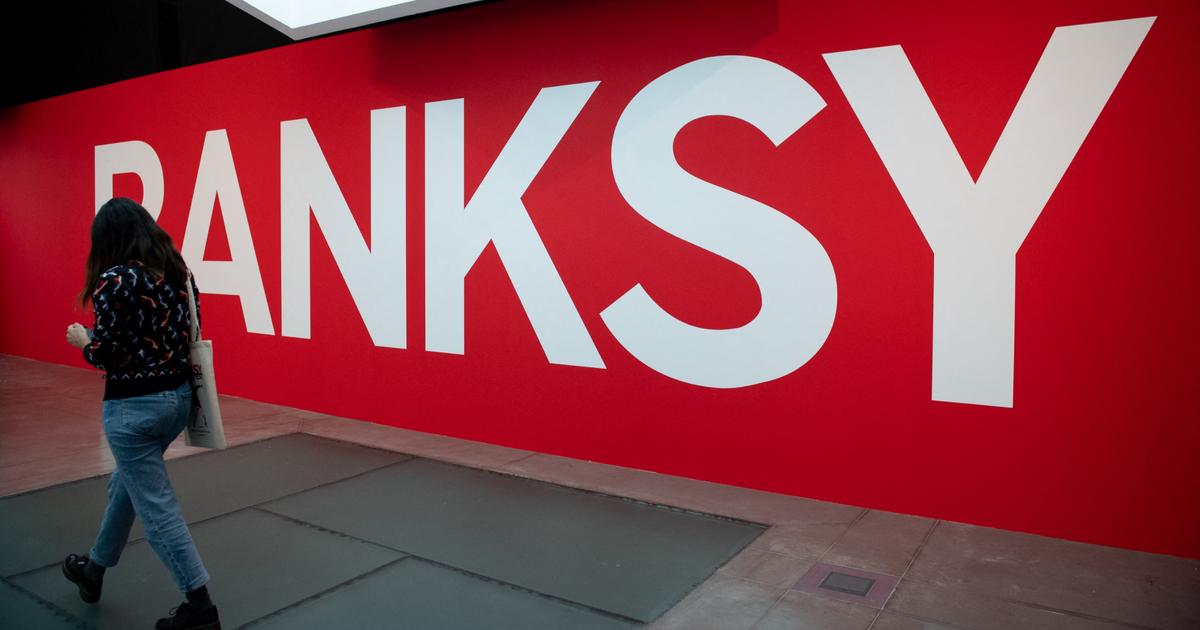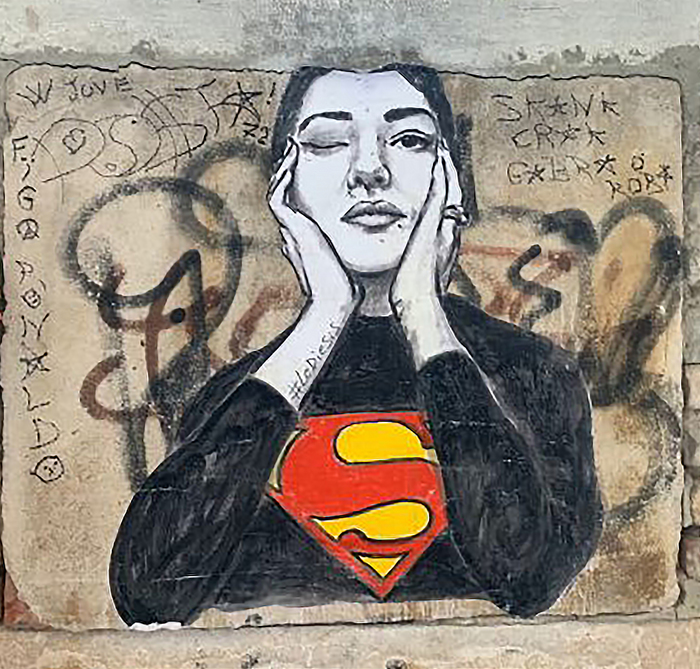"His work has as much nutritional value as a
McDonald's
happy meal
." This is how an article in the
Art Newspaper
magazine summarized
the critics' judgment of the American artist Brian Donnelly (better known by the acronym KAWS) in connection with
What Party
, his retrospective that can be seen at the Brooklyn Museum until September. However, it does not seem that the opinion of art critics has weighed negatively on an author - recognizable for his anthropomorphic figures with cross-shaped eyes - whose work has been sold at auction for 15 million dollars, and who has become this exhibition at one of the most popular cultural events of the season in New York.
The work of KAWS can be seen in museums and is also part of private collections such as SOLO (in Madrid), although given its street origins it is usually applied the label of
street art
, a type of artistic work characterized by being displayed in public spaces, usually urban. Facades of buildings, subway and train wagons, or even monuments, have been common supports of this mode of expression whose origin is usually set in the middle of the last century, although from the eighties it achieved a strong boost thanks to the youth community
artistic
guerrillas
flourishing in and around Manhattan.
In those days, the lines that separated the creation of vandalism were blurred, and even many wondered, to begin with, if some graffiti or furtive murals could be considered art.
Now the question is raised again, but there are new connotations in it that have to do with the change of status represented by KAWS and other related names.
Sculptures and paintings from the KAWS 'Age of Loneliness' exhibition at the National Gallery of Victoria, Melbourne, Australia Asanka Ratnayake / Getty Images
As Estrella de Diego, critic, curator and professor of Contemporary Art at the Complutense University explains, first of all a paradox must be pointed out. "If it's
street art
, what does he do in a museum?" “It is something that has already happened with Keith Haring and with Basquiat, and that revealed the contradiction of the discourse about something that supposedly aims to shake the system, not please it and work for it. Now [these artists] don't bother anyone because they have become aesthetic, which is a shame. It seems good to me that they enter museums, that they intervene in a space to which they have been invited or that they reach auctions, but that they change their name. Or that they open a store with their products, as Haring did in New York! ”.
Indeed, the North American Keith Haring (1958-1990) opened his
Pop Shop
in 1986
, a store that operated in Manhattan for two decades.
Like KAWS, Haring had started his career by doing graffiti in the city's public space, imposing his recognizable comic book style before gaining validation from the institutions.
Already ill as a result of HIV, he chose to paint his mural
Together we can stop AIDS
a particularly degraded area of Barcelona's El Raval neighborhood, with the idea that it was an ephemeral intervention.
However, in 1992 the Barcelona City Council commissioned a tracing to be carried out in order to preserve it.
Converted into a museum piece, the painting was deposited in the Macba, and has even been reproduced in other locations.
Artist Keith Haring paints his work on a large yellow wall for an art show in May 1985.Corbis / Getty Images
The market and museums have been fundamental agents of legitimation of art.
What is or should be considered art is a question that has been asked many times and answered many times, but if we pay attention to institutional theory - formulated by the philosopher George Dickie more than four decades ago - it is not so much about what it is in itself a certain object as the environment (the "world of art") in which it is presented.
A piece of wood washed up on a beach by the current will not be anything other than that, but if an artist exhibits it as an object found in an art center, the transmutation will have taken place.
This theory is put to the test when we talk about
street art
, which is supposedly conceived just to live outside the institutions. Does this negate its artistic value, then? Well, in the first place, nobody has said that the "world of art" excludes the streets of the city.
But this is not all. Miguel Zugaza, director of the Bilbao Fine Arts Museum -before the Prado Museum-, also highlights the disagreement that operates in this area. "The museum must record these street interventions but not replace their original meaning and location," he says. And it does not seem to rely too much on the current authority of museums to play its legitimizing role. "I suspect that nowadays the media have more capacity than museums to decide what is art or not before large audiences," he reflects. On the specific case of Banksy, whom he compares with the Spanish El Roto, he adds: “I think he is an exceptional illustrator, and without a doubt also a great publicist. His images and messages cause perplexity due to the unforeseen form of his appearance and are always extremely effective ”.
Pictured is the painting 'Girl with a Balloon' from Bansky's exhibition 'A Visual Protest', which took place at the Chiostro del Bramante in Rome on September 10, 2020.Mondadori Portfolio / Getty Images
General view of the exhibition 'Street Art - Bansky & Co. L'Arte allo Stato Urbano', at Palazzo Pepoli Vecchio on March 17, 2016 in Bologna, Italy.
Roberto Serra - Iguana Press / Getty Images
The mention of advertising takes us to the field of the market, which, on the other hand, has proven its effectiveness as a sender of certain messages. Banksy was already a popular artist when a work of his self-destroyed in the middle of the Sotheby's auction room minutes after the deck fell for a price greater than a million euros, but that action marked a before and after in how the public perceived his job. As for digital art, it didn't seem to be of much interest before the disproportionate prices attained by certain pieces of NFTs (a
non-expendable unit
, a unique digital item) signed by Beeple spread.
"Of all that we are experiencing with the NFT, I think there is a part that has come to stay, although we must separate the wheat from the chaff", says Sergio Sancho, director of the Urvanity fair, which will celebrate its fifth edition on 27 to May 30 in Madrid's COAM. Urvanity is the only fair in our country specialized in this type of artistic manifestation. Among the galleries that will meet there are Cerquone Gallery, Swinton Gallery, Badr El Jundi and La Gran.
The fair is defined as "a platform for the dissemination of New Contemporary Art", and Sancho is clear about its objectives. "One of our main missions is to bring to the public certain expressions that were not being considered in other fairs," he explains. “By giving it visibility, we know that the recognition of many of these artists by that
establishment
will come sooner or later. On the other hand, I don't know if we have to pay much attention to media phenomena, as the press is looking for the news and this leads people to end up thinking that it is a very banal world ”.
Digital paintings by artist Beeple at a crypto art exhibit titled 'Virtual Niche: Have You Ever Seen Memes in the Mirror?', One of the first physical 'blockchain' art exhibitions in the world.
Beijing on March 26, 2021. NICOLAS ASFOURI / AFP via Getty Images
Estrella de Diego's diagnosis is clear: “All this noise is part of this late-capitalist society that makes news and swallows everything that has been going on for decades.
Today it is simply an old-fashioned fashion ”.
Relying on market mechanisms to grant the status of artistic work responds to some logics that lead us to the terrain of economic liberalism.
And it can be argued that those are precisely the logics that
street art
is expected to oppose
.
Begoña Torres is the current director of the Lázaro Galdiano Museum, which houses a collection of eminently classical art (with works by El Greco, Zurbarán, Tiepolo or Goya), but before that she was in charge of the La Tabacalera art center in Madrid for a decade. where he carried out projects such as
Muros
(which turned the walls of the outer perimeter of the building's patio into an urban art space) and
Intramuros
(international meetings around this artistic movement), with which he gave full freedom to develop their proposals a total of 32 artists, between the collective Boa Mistura or Iñigo Sesma.
"For me,
street art
is one in which the artist reflects on the same society in which he is immersed, through a committed and disruptive art", he defines. "All these phenomena that take place in the street raise a certain debate about whether they should be considered as art or not, since they pivot on a thin border between aesthetic, political or social expression, and the possible desecration of architectural heritage and property. private ”.
In this sense, and only in our country, some controversial recent interventions can be cited. This is the case of Okuda, who painted in his usual colorful style a lighthouse in Ajo (Cantabria) amid strong criticism from experts in artistic heritage, against which he defended himself alluding to the increase in tourist influx. Or the aforementioned Boa Mistura, who once again added a multicolored skin to an austere concrete building by the architect Miguel Fisac in Getafe (Madrid), substantially altering its appearance. In this regard, Sergio Sancho believes that the experts should have the last word here: “The logical process of interventions in public space is through the approval of a local Heritage or Urban Landscape commission. Therefore, it is up to them to make these kinds of decisions ”.
The Lighthouse of the Cantabrian town of Ajo decorated by the artist Okuda San Miguel.Joaquin Gomez Sastre / Getty Images
Which does not exempt the creators themselves.
It is understood that a certain sensitivity to heritage should be part of the baggage with which an artist presents himself to the public and therefore acts, no matter how inflammatory his political message (when it is).
Estrella de Diego assesses these cases from a quite revealing laconism: "I have not followed the news closely, so I have no opinion, although I imagine that it is also interesting that I have not followed them."
"Not everything can be measured by the same standard," adds Begoña Torres. “From my point of view, being an urban artist also requires important commitments, both political and ethical, as well as permanent attention to current affairs. It is a way of life, a very effective resistance program against the standardization that surrounds us, in an action that is both activist and critical ”.
It is true that this critical spirit, that willingness to question the
status quo
, has been in the DNA of this type of art since its origins. And at the cost of certain risks, which range from the imposition of fines to the artist's own physical integrity. Estrella de Diego indicates that, if he should highlight any of his manifestations, he stays with "the anonymous graffiti artists who risk their lives to leave their mark on the top of the buildings of São Paulo: their work can only be seen from the highway" .
What seems clear is that a specific medium or specific technical means are not by themselves the ones that determine that something is art or not, nor that it is as nutritious as an industrial hamburger or a wild salmon fillet. But this is nothing new. "The day a museum is no longer interested in art where it is produced, it will no longer serve the purpose for which it was created as a public institution", Miguel Zugaza says. “In the same way, I think that we should not confuse art with technology. The Van Eyck brothers revolutionized universal art with oil painting, not because of the novelty of the new technique but because of the amazing use they were able to take from it to create works such as the
Arnolfini Marriage
or the
Ghent Polyptych
”.
'Escombro', by the artist Ignacio Pérez Jofre, a work that is part of the Urvanity fair in Madrid. Urvnity fair















